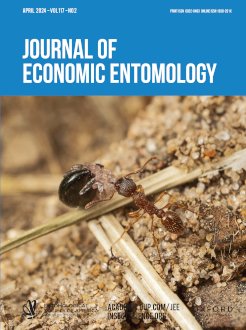The clover seed weevil, Tychius picirostris Fabricius, a serious pest of white clover, Trifolium repens L., grown for seed in western Oregon, causing feeding damage to flowers and developing seeds. Since 2017, white clover seed producers have anecdotally reported T. picirostris control failures using foliar pyrethroid insecticide applications. This mode of action (MoA) is an important chemical control option for T. picirostris management.To evaluate insecticide resistance selection to pyrethroids (bifenthrin) and other MoAs labeled for T. picirostris management (malathion and chlorantraniliprole), adult populations were collected from 8 commercial white clover grown for seed fields in the Willamette Valley, OR, in 2022 and 2023. Among collected Oregon populations, very high resistance ratios (RR50 = 178.00–725.67) were observed to technical grade bifenthrin and low to high resistance ratios (RR50 = 7.80–32.80) to malathion in surface contact assays compared to a susceptible Canadian field population. Moreover, >2.73 times the labeled rate of formulated product containing bifenthrin as the sole MoA was required to kill >50% of T. picirostris in topical assays. Synergistic assays with a mixed-function oxidase inhibitor, an esterase inhibitor, and a glutathione-S-transferase inhibitor revealed phase I and II detoxification enzymes are present in Oregon T. picirostris populations and confer metabolic resistance to bifenthrin.This is the first report of T. picirostris insecticide resistance selection to pyrethroid and organophosphate insecticides. Results will inform continued monitoring and insecticide resistance management strategies to slow the evolution of T. picirostris insecticide resistance selection in Oregon's white clover seed production.
How to translate text using browser tools
29 January 2024
Field-evolved pyrethroid resistance in Tychius picirostris (Coleoptera: Curculionidae) populations in Oregon white clover seed crops
Grace Tiwari,
Navneet Kaur,
Nicole P. Anderson,
K. Christy Tanner,
Danielle M. Lightle,
Alison R. Willette,
Jennifer K. Otani,
Amanda M. Jorgensen,
Calvin Yoder,
Seth J. Dorman
ACCESS THE FULL ARTICLE
It is not available for individual sale.
This article is only available to subscribers.
It is not available for individual sale.
It is not available for individual sale.

Journal of Economic Entomology
Vol. 117 • No. 2
April 2024
Vol. 117 • No. 2
April 2024
clover seed weevil
insecticide resistance
resistance mechanism
seed production
Trifolium repens L





